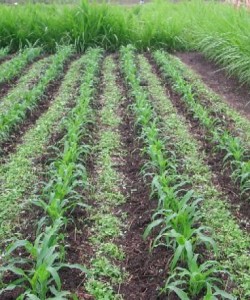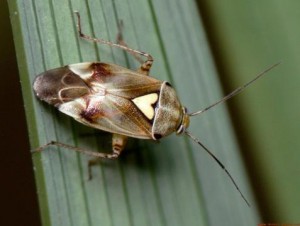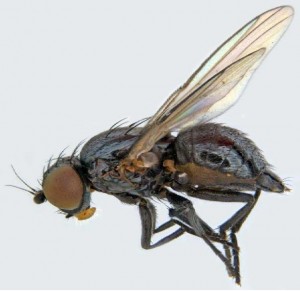By Gemelle Brion
I’m interested in farming practices that use the ecology of the farm to correct resource and pest imbalances. Intercropping is a prime example of such a practice. Practices that rely on on-farm ecology can reduce pesticide use, allow farmers to better understand the interplay of organisms on their farm, and are often more cost effective to the farmer.
The use of intercropping systems provides an option for insect control for organic farmers that are limited in their chemical use. Additionally, intercropping systems can be attractive to conventional growers as a cost-effective insect control solution.
Intercropping is the planting of more than one crop in close proximity as part of the same farming system. The design of intercropping systems can vary dramatically depending on the purpose of the intercrop for the farming operation. Intercropping produces the benefits of on-farm diversity, increased productivity, resource distribution balance, farm risk reduction, and weed and insect pest control.
Intercropping systems for insect pest control includes the planting of a crop that has a repellent effect, an attractant effect, or a combination of the two, on a targeted insect in close proximity to a crop that has the potential to be attacked by the insect. Here’s an overview of the three mechanisms of intercropping for insect pest control:
Trap cropping: A system that uses an attractant crop planted close to the production crop is called trap cropping. The plant that is used as an intercrop (trap crop) is more attractive than the production crop to the insect, so the insect is drawn to the trap crop. In conventional systems, insecticides can be applied to the trap crop alone, reducing the need for pesticide use on all acres. In organic systems, an Organic Materials Review Institute (OMRI) approved insecticide could be used on the trap crop, or a mechanical means of insect control can be used, such as using a tractor-mounted vacuum over the trap crop. A good example of a successful trap cropping system that uses field vacuums is found in the control of lygus bugs on strawberries in California.
Repellant intercrops: An intercrop that has a repellent effect can also be used for insect pest control. This often requires more rows of the intercrop to be planted than in a trap crop system. In this system, the repellent intercrop masks the production crop from the insect pest, deterring the insect from its host crop. Whether the repellency is due to chemicals emitted by the plant or due to the physical structure of the intercrop is unknown. An example of repellant intercrops can be seen in a recent study that showed that intercropping leeks with beans (host plant) had a repellent effect on the bean fly.
Push-pull cropping: A combination of repellent and attractant crops can be used in an intercropping system for insect pest control. This type of system was developed in Africa and is called a push-pull system. The attractant crop draws the insect in (acts as the “pull”) and the repellent crop deters the insect (acts as the “push”). The push-pull system that was developed in Africa protects corn from stem boring moth larvae by planting a grass that is more attractive to the moths, Napier grass, as a border and planting a repellent crop, Desmodium (a legume), in between the rows of corn.
Gemelle Brion is a masters student in the UVM Food Systems Graduate Program. She is studying intercropping systems with a focus on insect pest control in UVM’s Insect Agroecology Lab under the guidance of Professor Yolanda Chen.














